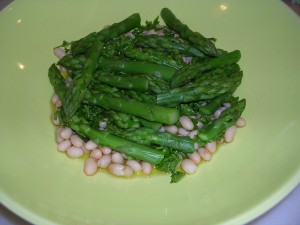 While most vegetables we grow are annuals, asparagus (Asparagus officinalis) is a delightful exception. This long-lived perennial is one of the first vegetables to harvest in spring. It’s native to the Mediterranean coast, which explains its love of well-drained, sandy soils.
While most vegetables we grow are annuals, asparagus (Asparagus officinalis) is a delightful exception. This long-lived perennial is one of the first vegetables to harvest in spring. It’s native to the Mediterranean coast, which explains its love of well-drained, sandy soils.
The spears or new shoots are harvested for 2 months in spring. I like them roasted with a balsamic vinegar in the oven. You can also saute them in butter or oil, add them to casseroles and salads or even make a soup from asparagus. After the harvest season, the spears grow into attractive ferns. I’ve even seen them grown as a ferny hedge to block an unsightly view.
When to Plant
Plant asparagus crowns in spring as a soon as the soil dries out. These spider-like, bare root plants are available on-line or at your local garden center.
Where to Plant
Plant asparagus on well drained, loose soil. Choose a location that will stay in full sun for years to come. Avoid places with trees that may eventually grow, shade, and reduce production in your asparagus bed.
How to Plant
Amend the soil with lime to raise the pH between 6.5 and 7.5. Dig a trench 6- to 10-inches deep (deeper in sandy soil, shallower in clay soil). At the bottom of the trench make small mounds of soil, spaced 12 inches apart, and drape the asparagus crown over each one. Amend the native soil with compost and backfill the trench so the crowns are 3 inches deep. Water well. After 6 weeks, fill the trench with the remainder of compost and native soil.
Care and Maintenance
Based on a soil test, add phosphorous or potassium fertilizer to keep your asparagus growing well. Keep the bed well weeded since asparagus doesn’t compete well with other plants. Add a 2-inch thick layer of straw or bark mulch around the ferns to help keep weeds at bay and keep the soil cool and moist. Keep the bed moist the first few years. Older asparagus beds are more tolerant of drought.
Watch for the asparagus beetle. This red beetles lays eggs on the asparagus ferns. The young slug-like, larvae feed on the ferns and can defoliate the plant. Handpick or spray pyrethrum to control adult beetles and Neem oil to control the larvae in the evening to avoid harming bees.
Fusarium wilt and rust disease may attack and kill asparagus, especially on poorly drained soils. Select your planting site wisely and purchase disease resistant varieties to avoid these problems.
Cut back old ferns in fall after they have yellowed and you’ve had a frost. Asparagus is winter hardy throughout the Northeast, so requires little winter protection.
Harvesting
Allow the spears to grow into ferns for the first two years without harvesting. This will strengthen the roots, and ultimately the plant, for the long haul. In the third year, harvest for 4 to 8 weeks. Harvest 1/2- inch or larger diameter spears when they’re 6-inches long. Leave thinner spears to grow into ferns.
To get white asparagus, blanch (block the light) the spears once they emerge from the ground by mounding soil over them or covering them with a pot. White asparagus has a more tender texture and milder flavor
Additional Information
The best varieties for our region are the Jersey hybrids. These Rutgers University bred varieties are more productive and disease resistant than older varieties. They also produce mostly male spears and ferns. This means there are few female shoots producing red berries. The berries take energy away from production and when the seeds in the berries sprout, can become weeds in the garden. ‘Jersey Knight’ grows well in heavier soils. ‘Jersey Supreme’ is a high yielding variety with good disease resistant. While not part of the all-male Jersey series, ‘Purple Passion’ is unique for its purple colored spears and ferns. The spears turn green when cooked.
Text excepted from the Northeast Fruit and Vegetable Gardening book.



